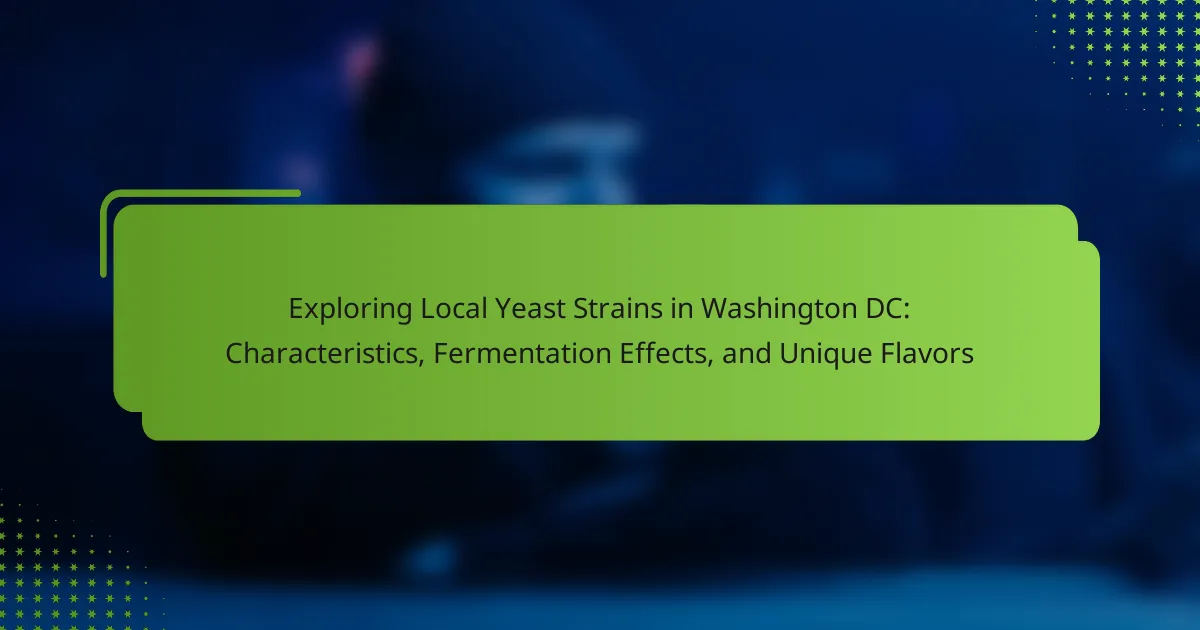Local yeast strains are specific varieties of yeast found in Washington DC that play a vital role in fermentation processes for food and beverages. These strains significantly influence the flavor, aroma, and texture of products, enhancing the complexity of craft beers and breads. Research indicates that local yeast strains improve fermentation efficiency and stability while adapting to the region’s environmental conditions. The unique flavors produced by these strains, influenced by local flora and fauna, contribute to the distinct sensory profiles of regional products. This article explores the characteristics, fermentation effects, and unique flavors of local yeast strains in Washington DC, emphasizing their importance in preserving culinary traditions and enhancing flavor diversity.

What are Local Yeast Strains and Why are They Important?
Local yeast strains are specific varieties of yeast that are naturally found in a particular geographic area. They play a crucial role in fermentation processes, influencing flavor, aroma, and texture in food and beverages. Local yeast strains contribute to the unique characteristics of regional products. For example, they can enhance the complexity of beer and bread by imparting distinctive flavors. Research shows that these strains can also improve fermentation efficiency and stability. Additionally, local strains often exhibit better adaptation to local environmental conditions. This adaptability can lead to more consistent and high-quality products. Overall, local yeast strains are vital for preserving regional culinary traditions and enhancing the diversity of flavors in Washington DC.
How do Local Yeast Strains Differ from Commercial Yeast?
Local yeast strains differ from commercial yeast in their genetic diversity and fermentation characteristics. Local strains often originate from specific environments, resulting in unique flavor profiles. These strains may adapt to local conditions, influencing fermentation speed and byproduct production. Commercial yeast, on the other hand, is typically standardized for consistent performance. It is bred for specific traits, such as high fermentation efficiency and predictable results. Research indicates that local strains can enhance the complexity of flavors in fermented products. A study by R. J. P. Ferreira et al. highlights how indigenous yeasts contribute to distinct sensory attributes in wines.
What are the key characteristics of local yeast strains?
Local yeast strains exhibit several key characteristics. They are often adapted to specific environmental conditions. This adaptation includes temperature tolerance and nutrient availability. Local strains may also possess unique flavor profiles. These flavors arise from the specific substrates available in the region. Additionally, local yeast strains can have varying fermentation rates. This variability affects the overall fermentation process and product quality. Studies show that local strains contribute to the distinct taste of regional products. For example, research indicates that yeast diversity enhances beer and bread flavors in local markets.
Why are local yeast strains significant for fermentation?
Local yeast strains are significant for fermentation because they enhance flavor complexity and fermentation efficiency. These strains adapt to specific environmental conditions, resulting in unique flavor profiles. Local yeasts often produce distinct aromatic compounds that contribute to the overall sensory experience. Studies show that using local strains can improve fermentation rates and consistency. Additionally, they can enhance the nutritional profile of fermented products. Research indicates that local yeast strains can also exhibit better tolerance to regional fermentation conditions. This adaptability makes them valuable for producing region-specific beverages.
What Role Does the Environment Play in Yeast Strain Characteristics?
The environment significantly influences yeast strain characteristics. Factors such as temperature, humidity, and nutrient availability shape yeast behavior. For instance, warmer temperatures can accelerate fermentation rates. Different nutrient sources can lead to varied flavor profiles in the final product. Additionally, local microbial communities can affect yeast performance. Research shows that yeast strains adapt to their environments, enhancing their survival and fermentation efficiency. A study by Varela et al. (2018) highlights how environmental factors directly impact yeast metabolism and flavor production.
How does the climate of Washington DC influence yeast strains?
The climate of Washington DC influences yeast strains by affecting their fermentation behavior and growth rates. The region experiences hot, humid summers and mild winters. These conditions create an environment that favors certain yeast strains over others. High humidity can enhance yeast activity, leading to faster fermentation. Warm temperatures may also promote the growth of wild yeast, which can introduce unique flavors. Conversely, cooler temperatures in winter can slow down fermentation processes. This seasonal variation impacts the types of yeast that thrive in the area. Local brewers often select yeast strains that are well-suited to these climatic conditions. This selection process results in distinct flavor profiles in locally produced beverages.
What unique environmental factors contribute to local yeast diversity?
Unique environmental factors that contribute to local yeast diversity include temperature, humidity, and substrate availability. Temperature affects yeast metabolism and growth rates. In Washington DC, seasonal variations create distinct yeast populations. Humidity levels influence yeast survival and reproduction. High humidity can foster diverse microbial communities. Substrate availability, such as fruits and grains, provides essential nutrients for yeast. The urban environment of DC introduces unique organic materials, enhancing yeast diversity. Studies show that localized conditions lead to unique yeast strains adapted to specific niches.

How Do Local Yeast Strains Affect Fermentation Processes?
Local yeast strains significantly influence fermentation processes. They contribute unique flavors and aromas to the final product. These strains have adapted to local environmental conditions, impacting their fermentation efficiency. For example, local temperature and humidity levels affect yeast activity and growth rates. Different yeast strains can also produce varying levels of alcohol and carbon dioxide during fermentation. Research shows that indigenous yeast can enhance the complexity of flavors in beverages. A study by the American Society of Brewing Chemists found that local strains can improve the overall quality of craft beers. This adaptability makes local yeast strains essential for regional fermentation practices.
What are the specific fermentation effects of local yeast strains?
Local yeast strains can significantly influence fermentation effects. They contribute to distinct flavor profiles and aroma compounds in fermented products. Different strains produce varying levels of esters and phenols, impacting taste and scent. Local conditions, such as temperature and humidity, further affect yeast activity. These strains can enhance fermentation rates and improve alcohol yield. Additionally, local yeast can impart unique regional characteristics to beverages. Research shows that local strains often exhibit better adaptation to specific environments. This results in more consistent fermentation outcomes compared to commercial yeast.
How do different yeast strains impact flavor profiles?
Different yeast strains significantly impact flavor profiles in fermentation. Each strain produces unique compounds during fermentation, influencing taste and aroma. For example, Saccharomyces cerevisiae is known for its clean fermentation and fruity esters. In contrast, Brettanomyces can impart earthy and funky flavors.
Research indicates that yeast can produce various phenols and esters, which contribute to the overall flavor complexity. Specific strains can enhance certain flavor notes, such as floral, spicy, or citrus characteristics. The fermentation temperature and conditions further influence these outcomes.
In Washington DC, local yeast strains may exhibit distinct profiles due to environmental factors. This local variation can lead to unique flavor experiences in beverages produced in the area.
What fermentation characteristics are unique to Washington DC yeast?
Washington DC yeast exhibits unique fermentation characteristics such as a high tolerance to varied temperatures. This yeast thrives in the diverse climate of the region, allowing for consistent fermentation across seasons. Additionally, it has a distinct flavor profile, often imparting fruity and floral notes to the final product. These flavors are a result of the specific strains adapted to local environmental conditions. Research indicates that Washington DC yeast can produce esters and phenols at higher levels compared to other yeast strains. This results in enhanced complexity in the beverages produced. The local microbiome also influences these fermentation traits, contributing to a unique fermentation ecosystem.
Why is Understanding Fermentation Effects Important for Local Producers?
Understanding fermentation effects is crucial for local producers because it directly influences the quality and flavor of their products. Fermentation affects the taste, aroma, and texture of foods and beverages. Local producers can harness specific yeast strains to create unique flavors that reflect regional characteristics. Knowledge of fermentation also aids in optimizing production processes. This can lead to improved consistency and efficiency in product outcomes. Furthermore, understanding fermentation can enhance the nutritional value of products. Producers can meet consumer demand for artisanal and locally sourced goods by leveraging fermentation effects. Ultimately, this knowledge supports local economies and promotes sustainable practices.
How can producers leverage local yeast strains for better products?
Producers can leverage local yeast strains to enhance product quality and flavor profiles. Local yeast strains often exhibit unique fermentative characteristics. These characteristics can contribute to distinct flavors and aromas in products like beer, bread, and wine. Utilizing local strains can also improve fermentation efficiency. Research has shown that local yeast can adapt better to regional conditions. This adaptation leads to more consistent fermentation results. For example, studies indicate that yeast strains from specific locales can produce more complex flavor compounds. By integrating local yeast, producers can differentiate their products in a competitive market.
What are the potential challenges of using local yeast strains?
Local yeast strains can present several challenges in fermentation processes. One challenge is variability in fermentation performance. Local strains may exhibit inconsistent fermentation rates and flavor profiles. This can lead to unpredictable results in the final product. Another challenge is potential contamination. Local yeast may carry wild microbes that can spoil the fermentation. Additionally, local strains may have lower tolerance to alcohol or environmental stress compared to commercial strains. This can limit their usability in certain brewing or baking applications. Lastly, lack of research on specific local strains can hinder optimization. Without established guidelines, brewers may struggle to achieve desired outcomes.

What Unique Flavors Emerge from Local Yeast Strains?
Local yeast strains produce unique flavors that reflect their specific environments. These flavors often include fruity, floral, and earthy notes. The diversity of local flora and fauna influences the yeast’s metabolic processes. For example, yeast from Washington DC may exhibit hints of apple or citrus due to local fruit availability. Some strains can impart spicy or herbal undertones, influenced by regional plants. Research shows that yeast flavors can significantly affect the final product, enhancing complexity. A study by De Schutter et al. (2020) highlights how local yeast contributes distinct sensory profiles in fermentation. This underscores the importance of local yeast in crafting unique beverages.
How do local yeast strains contribute to distinct flavor profiles?
Local yeast strains significantly influence distinct flavor profiles in fermentation. Each strain possesses unique metabolic pathways that produce specific flavor compounds. These compounds include esters, phenols, and organic acids, which contribute to the overall taste and aroma. For example, certain local strains may produce fruity esters, while others may generate spicy phenols. The diversity of yeast strains in a region leads to a variety of flavor expressions. In Washington DC, local yeast strains are adapted to the environment, enhancing the local terroir. Research shows that yeast strains from specific locales can impart regional characteristics to beverages. This results in a unique sensory experience that reflects the local culture and climate.
What are some examples of unique flavors from Washington DC yeast?
Washington DC yeast strains exhibit unique flavors such as fruity, spicy, and earthy notes. These flavors arise from the diverse microbial environment in the region. Specific examples include a banana-like estery flavor and peppery spice from certain wild yeast strains. The local flora contributes to these distinct profiles. Fermentation conditions, including temperature and substrate, further influence flavor development. Studies have shown that local yeast can enhance the complexity of craft beers and artisanal breads. This reflects the unique terroir of Washington DC’s yeast.
How do these flavors compare to those produced by commercial yeast?
Flavors produced by local yeast strains differ significantly from those generated by commercial yeast. Local yeast strains often impart more complex and diverse flavor profiles. This complexity results from the unique microbial interactions present in specific environments. In contrast, commercial yeast typically produces consistent and predictable flavors. The uniformity of commercial yeast comes from its selective breeding for specific traits. Research shows that wild yeast can enhance aromatic compounds, contributing to distinct taste experiences. Local strains can also introduce regional characteristics, reflecting the local terroir. This variability is less common in products made with commercial yeast. Overall, local yeast strains offer a richer and more varied flavor landscape.
What are the Best Practices for Using Local Yeast Strains?
Best practices for using local yeast strains include selecting the right strain for the specific fermentation process. Local yeast strains can enhance flavors and aromas unique to the region. It is essential to conduct thorough testing to determine the yeast’s fermentation characteristics. Monitoring fermentation temperature is crucial for optimal yeast performance. Using appropriate nutrient levels can support yeast health and activity. Regularly checking for off-flavors ensures quality control throughout the process. Additionally, documenting the fermentation process helps in replicating successful batches. Engaging with local yeast culture fosters community and knowledge sharing among brewers.
How can brewers and bakers effectively cultivate local yeast?
Brewers and bakers can effectively cultivate local yeast by sourcing it from their environment. They should collect samples from local fruits, flowers, or grains. These sources often harbor wild yeast that thrives in specific climates.
Once collected, the samples must be mixed with a sugar solution to encourage yeast growth. A common method is to use a mixture of water and sugar. This solution creates an ideal environment for yeast to multiply.
Brewers and bakers should monitor the mixture for signs of fermentation, such as bubbling or foaming. This indicates that yeast is active and multiplying.
After a few days, the cultivated yeast can be used in brewing or baking processes. This method not only captures local yeast strains but also enhances the flavor profile of the final products.
Research shows that using local yeast can result in unique flavors that reflect the regional terroir. This practice connects the products to their local environment, making them distinct.
What tips can enhance the flavor outcomes when using local yeast strains?
Using local yeast strains can enhance flavor outcomes by optimizing fermentation conditions. Start by selecting yeast strains that are well-adapted to the local environment. This can lead to unique flavor profiles that reflect the region’s terroir. Adjust fermentation temperatures to suit the specific yeast strain. Different temperatures can accentuate or suppress certain flavor compounds. Monitor the fermentation duration closely. Longer fermentations can develop more complex flavors. Incorporate local ingredients into the fermentation process. This can create a synergy between the yeast and the local flora. Regularly taste the product during fermentation. This allows for adjustments to be made in real-time. Lastly, document the process thoroughly. This helps in replicating successful flavor outcomes in future batches.
Local yeast strains in Washington DC are specific varieties of yeast that thrive in the region’s unique environmental conditions, significantly influencing fermentation processes and the flavor profiles of local products. These strains differ from commercial yeast in terms of genetic diversity and fermentation characteristics, often resulting in enhanced complexity and adaptability. The article explores the key attributes of local yeast strains, their fermentation effects, and the distinct flavors they contribute, emphasizing their importance for local producers and culinary traditions. Additionally, it highlights best practices for cultivating and utilizing these strains to optimize product quality and flavor outcomes.
